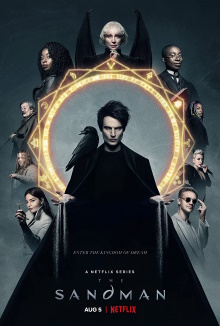It’s really quite insane that the current Golden Age of television has brought us an actually good adaptation of a property as notoriously unfilmable as The Sandman. I’ve never read the Neil Gaiman comic book series not being much of a DC fan but I couldn’t help but hear of it and even learned many of the stories in it through sheer osmosis. As I understand it, this isn’t a perfectly faithful adaptation and distances itself from being too directly tied to the DC universe. But it’s faithful enough in spirit and intention as approved by Gaiman himself that its far better than I ever imagined could be possible to see within my lifetime.
This first season adapts a few early stories from the comics, beginning with Morpheus, the personification of the Dreaming, being captured by the British magician Roderick Burgess in 1916. Morpheus is uncommunicative and concedes nothing but Burgess steals his tools and uses them to gain power ad wealth. Morpheus is able to free himself only 106 years later, long after Burgess has died. He returns, weakened to his kingdom in the Dreaming to find it in ruins, and many of his Dreams and Nightmares scattered or escaped. To regain his full power, he must retrieve his three totems of power which have been stolen by Burgess’ lover, Ethel Cripps. These adventures involve him dealing with Johanna Constantine, visiting Lucifer in Hell and seeking out the son of Burgess and Cripps. Subsequent stories have Morpheus finding his purpose again, tracking down the escaped Dreams and Nightmares and confronting a vortex, a human born with the powerful ability to manipulate dreams.
One of the most satisfying things about this series for me is that it unfurls at a decent pace and doesn’t drag things out. The Sandman’s escape from imprisonment and recovery of his tools takes up only about half of the season. At times, the focus falls mainly on other characters such as Burgess’ illegitimate son John Dee, or the dream vortex Rose Walker, to tell their stories. I love this more episodic take which takes a more expansive and meandering view of the fantastic setting. I think it also bodes well for the show’s longevity that not every episode must be part of a larger story arc. My favorite episode might be the one featuring Hob Gadling, the man who Death has spared, which is completely standalone. The decisions to update the story as appropriate are well-considered and appropriate. Some fans were upset that John Constantine was changed to Johanna Constantine but the original Constantine carries so much baggage with him that starting with a clean slate for the character seems best to me. My one complaint is that whatever budget they were given to work with, they could have used more. The Dreaming needs to look more grandiose, more fantastic and the changes that ripple out through the waking world more extensive. The show looks okay as it is but it deserves to look great.
